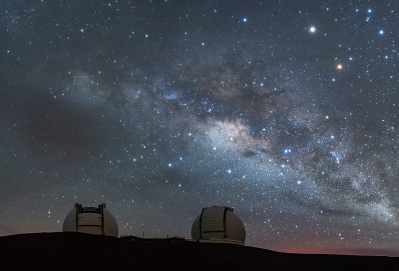Early Monday morning, while many of us will be putting the finishing touches — or just beginning, ahem — on our Christmas preparations, solar scientists will hold their collective breath as they wait for word from the Parker Solar Probe’s record-setting passage through the sun’s atmosphere. The probe, which has been in a highly elliptical solar orbit since its 2018 launch, has been getting occasional gravitational nudges by close encounters with Venus. This has moved the perihelion ever closer to the sun’s surface, and on Monday morning it will make its closest approach yet, a mere 6.1 million kilometers from the roiling photosphere. That will put it inside the corona, the sun’s extremely energetic atmosphere, which we normally only see during total eclipses. Traveling at almost 700,000 kilometers per hour, it won’t be there very long, and it’ll be doing everything it needs to do autonomously since the high-energy plasma of the corona and the eight-light-minute distance makes remote control impossible. It’ll be a few days before communications are re-established and the data downloaded, which will make a nice present for the solar science community to unwrap.
relativity9 Articles
Demo Relativity For A C-Note
If you are a science fiction fan, you probably hate the theory of relativity. After all, how can the Enterprise get to a new star system every week if you can’t go faster than the speed of light? [Nick Lucid] wants to set you straight: it is real, and you can prove it to yourself for under $100.
The idea uses muons created in our atmosphere by cosmic rays colliding with gasses in the atmosphere. So how do you detect muons yourself? [Nick] shows you how to do it with a fish tank, dry ice, and rubbing alcohol. If that sounds like a cloud chamber, you aren’t wrong.
A cloud chamber is undeniably cool, but how does it prove relativity? You’ll see several kinds of particles interacting with your cloud chamber, but you can tell which ones are muons by the size and motion of the streaks. The muons don’t last very long. So you’d expect very few muons to make it to the surface of the Earth. But they not only reach the surface but go deep under it, as well.
So how do you explain it? Relatively. The muon experiences its average 2.2 microseconds lifetime in what appears to us to be over 150 microseconds, even if it is moving relatively slowly for a muon. Some muons are faster or live longer, so we see a lot of them hit the Earth every minute of every day. This is due to time dilation and also explains length contraction because the muon moves at a certain speed, yet it appears to go further to us than to the muon.
Coincidentally, we recently discussed this same effect relative to using muons for underground navigation. If you want an easier way to count muons with a computer, you can build a detector for about the same price as the cloud chamber.
Andrea Ghez Gazes Into Our Galaxy’s Black Hole
Decades ago, Einstein predicted the existence of something he didn’t believe in — black holes. Ever since then, people have been trying to get a glimpse of these collapsed stars that represent the limits of our understanding of physics.
For the last 25 years, Andrea Ghez has had her sights set on the black hole at the center of our galaxy known as Sagittarius A*, trying to conclusively prove it exists. In the early days, her proposal was dismissed entirely. Then she started getting lauded for it. Andrea earned a MacArthur Fellowship in 2008. In 2012, she was the first woman to receive the Crafoord Prize from the Royal Swedish Academy of Sciences.

Now Andrea has become the fourth woman ever to receive a Nobel Prize in Physics for her discovery. She shares the prize with Roger Penrose and Reinhard Genzel for discoveries relating to black holes. UCLA posted her gracious reaction to becoming a Nobel Laureate.
A Star is Born
Andrea Mia Ghez was born June 16th, 1965 in New York City, but grew up in the Hyde Park area of Chicago. Her love of astronomy was launched right along with Apollo program. Once she saw the moon landing, she told her parents that she wanted to be the first female astronaut. They bought her a telescope, and she’s had her eye on the stars ever since. Now Andrea visits the Keck telescopes — the world’s largest — six times a year.
Andrea was always interested in math and science growing up, and could usually be found asking big questions about the universe. She earned a BS from MIT in 1987 and a PhD from Caltech in 1992. While she was still in graduate school, she made a major discovery concerning star formation — that most stars are born with companion star. After graduating from Caltech, Andrea became a professor of physics and astronomy at UCLA so she could get access to the Keck telescope in Mauna Kea, Hawaii.

The Center of the Galaxy
Since 1995, Andrea has pointed the Keck telescopes toward the center of our galaxy, some 25,000 light years away. There’s a lot of gas and dust clouding the view, so she and her team had to get creative with something called adaptive optics. This method works by deforming the telescope’s mirror in real time in order to overcome fluctuations in the atmosphere.
Thanks to adaptive optics, Andrea and her team were able to capture images that were 10-30 times clearer than what was previously possible. By studying the orbits of stars that hang out near the center, she was able to determine that a supermassive black hole with four millions times the mass of the sun must lie there. Thanks to this telescope hack, Andrea and other scientists will be able to study the effects of black holes on gravity and galaxies right here at home. You can watch her explain her work briefly in the video after the break. Congratulations, Dr. Ghez, and here’s to another 25 years of fruitful research.
Way To Go, Einstein; His Time Spent Being Wrong
When you hear someone say “Einstein”, what’s the first thing that pops into your head? Is it high IQ… genius… or maybe E=MC2? Do you picture his wild grey hair shooting in all directions as he peacefully folds the pages back from his favorite book? You might even think of nuclear bombs, clocks and the Nobel Prize. It will come as a surprise to many that these accomplishments were a very small part of his life. Indeed, Einstein turned the world of classical physics upside down with his general theory of relativity. But he was only in his early twenties when he did so.
What about the rest of his life? Was Einstein a “one-hit-wonder”? What else did he put his remarkable mind to? Surely he tackled other dilemmas that plagued the scientific world during his moment in history. He was a genius after all… arguably one of the smartest people to have ever walked the earth. His very name has become synonymous with genius. He pulled the rug out from under Isaac Newton, whose theories had held the universe together for over 300 years. He talked about enigmatic concepts like space and time with an elegance that laid bare the beauty hidden within their simplicity. Statues have been made of him. His name and face are recognizable across the globe.
But when you hear someone say “Einstein”, do you think of a man who spent the better half of his life… being wrong? You should.
Continue reading “Way To Go, Einstein; His Time Spent Being Wrong”
Eclipse 2017: Was Einstein Right?
While most people who make the trek to the path of totality for the Great American Eclipse next week will fix their gazes skyward as the heavenly spectacle unfolds, we suspect many will attempt to post a duck-face selfie with the eclipsed sun in the background. But at least one man will be feverishly tending to an experiment.
On a lonely hilltop in Wyoming, Dr. Don Bruns will be attempting to replicate a famous experiment. If he succeeds, not only will he have pulled off something that’s only been done twice before, he’ll provide yet more evidence that Einstein was right.
Get Ready For The Great Eclipse Of 2017
On August 21, 2017, the moon will cast its shadow across most of North America, with a narrow path of totality tracing from Oregon to South Carolina. Tens of millions of people will have a chance to see something that the continental US hasn’t seen in ages — a total eclipse of the sun. Will you be ready?
The last time a total solar eclipse visited a significantly populated section of the US was in March of 1970. I remember it well as a four-year-old standing on the sidewalk in front of my house, all worked up about space already in those heady days of the Apollo program, gazing through smoked glass as the moon blotted out the sun for a few minutes. Just watching it was exhilarating, and being able to see it again and capitalize on a lifetime of geekiness to heighten the experience, and to be able to share it with my wife and kids, is exciting beyond words. But I’ve only got eight months to lay my plans! Continue reading “Get Ready For The Great Eclipse Of 2017”
The Infinite Monkey Cage And General Relativity
If you are British, you probably already know where this is going. For the rest of you, it might help to know that The Infinite Monkey Cage is an odd little show on BBC Radio 4 (and they’ve been on tour, too). It is the show that asks a question you probably never asked: “What would happen if a physicist and a comedian had a radio show?”
The answer, it turns out, is some science information that is anything but dry. If you are prone to listening to radio programs or podcasts, you might find some interesting tidbits in the Cage. A two-part episode on general relativity was especially interesting although it isn’t exactly like their regular program.
The physicist in question is [Brian Cox] who is an Advanced Fellow of particle physics at the University of Manchester. The comic, [Robin Ince] is not only a comedian, but also a writer, an impressionist, and has an honorary doctorate from Royal Holloway, University of London.
If you poke around the BBC’s site, you can find plenty of episodes to stream or download. General relativity is just one of the topics. You might also enjoy episodes on artificial intelligence or the science of sound.
If you need more comedy connections, consider that [Eric Idle] is responsible for the theme song. Of course, we cover relativity (and other topics) in a hopefully amusing style. Americans typically get British humor, or they don’t. There’s no in between. The good part about these is that if you don’t get the humor, there’s still the science content. Contrast this to the very funny (if you get it) Look Around You series that is probably not the best place to get scientific information (see the video below).
Continue reading “The Infinite Monkey Cage And General Relativity”


















